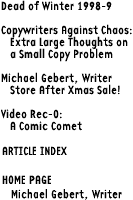


I PULLED INTO CHECKERS AND ORDERED a medium Coke. “Your total’s $1.42, please drive through,” the voice said.
“Huh?” I said, surprised. “The sign says $1.09. There can’t be that much tax, even in Chicago.”
“The prices went up. But we made the drinks bigger,” he explained. “We just haven’t changed all the signs yet.”
I left aside the fascinating question of just which signs an all-drive-through restaurant had changed if not the ones in the drive-through, and said, “But if both the size and the price went up, then I’m not getting a better deal. You’re just forcing me to buy a large, under the pretense that it’s a medium.”
“Have a nice day,” he replied as he passed me a cup like a tree trunk. I gripped it firmly with both hands, and searched for a place besides the now comically tiny cupholder to put it.
Nutritionists have warned about “portion creep,” the fact that in America the standard size for, say, a lunchtime soft drink has gone from a 10-oz. Coke bottle to a 64-oz. Might-E Guzzle. But I want to write about the same phenomenon from a copywriter’s point of view.
Try to order a small drink somewhere—a burger joint, the movies, you name it. You can’t. Smalls don’t exist any more. That’s because someone became convinced that Small was a negative, and so the word for Small is now Regular. (Leading inevitably to this conversation, with its echoes of Abbott and Costello: “A regular Coke.” “Diet?” “No, regular.” “What size?”)
So instead of Small, Medium and Large, our choices are now Child, Regular, Value, Super Sav-R, Xtra Burl-E, and Extreme. And any sense of a clear relationship between them is lost... somewhere between Regular and Medium.
This process (like so many things) reaches its height of absurdity at Starbucks, where the sizes of coffee are Tall, Grande, and Venti. Three descriptors, all of which mean large, two of which aren’t even in English—and none of which has any relationship to the others. The first indicates height, the next is an Italian word for volume, and the third, with a sardonic mathematical precision, means “twenty”—its exact weight.
My complaint may itself seem small, or at least Andy Rooneyishly cranky. But if the doctor’s credo starts off “First, do no harm,” the copywriter’s must begin, “First, don’t confuse”—even when waxing pretentious and giving coffee drinks names like cars (“A decaf Mocha Gran Torino with extra Corinthian leather, please”). It’s precisely this business of picking your words with care and precision that separates the good copywriters... from the, uh, regular ones.
